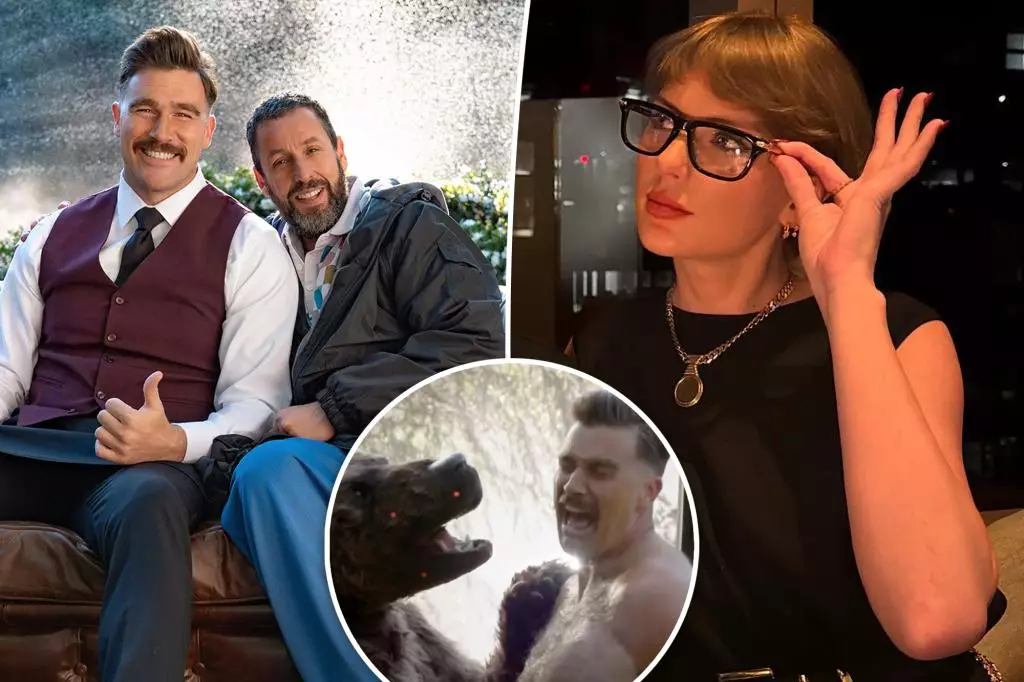In today’s entertainment landscape, the allure of celebrity cameos often transcends the screen, fueling social media speculation and fan-driven narratives. The recent whispers around Taylor Swift’s possible cameo in “Happy Gilmore 2” exemplify this phenomenon perfectly. Fans love to uncover hidden details, feeding into a collective desire for mystery and exclusivity. When Netflix released a behind-the-scenes clip hinting at Travis Kelce’s humorous honey scene, viewers immediately fixated on a seemingly inconspicuous detail: a bear costume. The buzz intensified when fans speculated that the woman inside that costume was Swift herself, adding an extra layer of intrigue.
This dynamic underscores a fundamental truth—audiences aren’t passive consumers. They are active participants in crafting the stories they want to see. Social media platforms amplify this curiosity, turning small details into impossible-to-ignore theories. Netflix’s subtle engagement, replying with an eyes emoji, fueled the fire even further. Such interactions, whether intentional or not, demonstrate how celebrity culture increasingly relies on a participatory model where fans feel empowered to decode and connect dots.
The Mythology of Celebrity Cameos and Behind-the-Scenes Rumors
Cameos have long been a staple in Hollywood—surprising fans and adding depth to narratives. However, contemporary fans aren’t just interested in who appears; they want to believe in hidden stories and secret alliances. When Taylor Swift promotes “Happy Gilmore 2″ and hints at enjoying it immensely, she subtly fuses her star power with the movie’s popularity. Her endorsement transforms her from a musician into a cultural icon capable of impacting film viewership, especially among her vast following.
The idea that Swift might be in a bear suit is particularly compelling because it blurs the boundaries between reality and fantasy. In an era where social media can make or break a career, the slightest hint can spark a viral sensation. The fan comments—”Dying to know if it’s Taylor” or expressing hope that she’s involved—are testaments to how deeply fans crave intimacy with their idols. This blending of fiction and truth creates a narrative that elevates the mundane into mythic storytelling, reinforcing the celebrity’s omnipresence in fans’ lives.
The Symbiotic Relationship Between Celebrities and Fans
Taylor Swift’s association with Kelce and her public support of his endeavors exemplify her shrewd approach to maintaining relevance and relatability. Her subtle promotion on Instagram, coupled with her enthusiastic praise for “Happy Gilmore 2,” reinforces her status not just as a music icon but as a pop culture influencer capable of shaping perceptions across multiple domains.
Similarly, Adam Sandler’s admiration for Swift adds another layer to this interconnected web. His admiration, coupled with his decision not to ask her for a cameo—citing respect for her busy schedule—illustrates an understanding of her standing and importance. Moreover, Kelce’s foray into acting, bolstered by Swift’s support, highlights how modern relationships often transcend romance, becoming strategic alliances that benefit public perception and personal branding.
This mutual reinforcement creates a feedback loop; fans see their favorite celebrities supporting each other, enhancing the narrative of authenticity. Whether or not Swift was genuinely in the bear costume, the myth persists, and it serves a larger purpose: maintaining cultural relevance through shared stories, hints, and accidental revelations.
Why These Stories Matter in Today’s Culture
What makes these celebrity-driven theories so impactful isn’t just about the entertainment itself—it’s about how they reflect societal values. In a world obsessed with instant gratification, fans crave exclusivity. The possibility that Taylor Swift—an artist who has mastered her brand—could secretly appear in a fun, absurd scene adds a layer of excitement that pure content rarely offers. It transforms everyday viewing into an interactive quest for authenticity.
Furthermore, it signals an evolution in celebrity-fan dynamics. Stars no longer solely rely on traditional media or their work to communicate; instead, they use subtle clues, social media breadcrumbs, and playful responses to deepen their connection with fans. This approach fosters a community where fans feel like collaborators in the celebrity’s universe, blurring the lines between performer and supporter.
Ultimately, these stories are more than mere entertainment—they become cultural touchstones. They remind us that in a digital age, myth-making and storytelling have shifted from folklore to social media, and that celebrity appearances—real or imagined—are powerful tools for shaping public consciousness and sustaining fan engagement.

